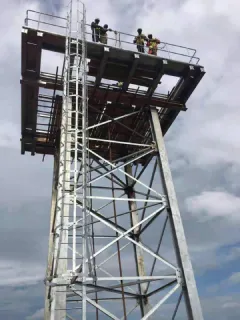loading...
- No. 9, Xingyuan South Street, Dongwaihuan Road, Zaoqiang County, Hengshui, Hebei, China
- admin@zjcomposites.com
- +86 15097380338
- Welcome to visit our website!
grp grating specification
Understanding GRP Grating Specifications
Glass Reinforced Plastic (GRP) grating, also known as fiberglass grating, is widely used in industries where anti-corrosive and lightweight materials are essential. With its unique properties, GRP grating offers significant advantages over traditional materials like steel or wood. This article delves into the specifications of GRP grating, highlighting its features, applications, and benefits.
What is GRP Grating?
GRP grating is a composite material created by combining glass fibers with a resin matrix, resulting in a structure that exhibits high strength, durability, and resistance to harsh environmental conditions. The grating is manufactured in various styles, including molded and pultruded types, which cater to different industrial needs.
Key Specifications
1. Load-Bearing Capacity One of the critical specifications of GRP grating is its load-bearing capacity, which is usually determined by the panel size, the spacing of the supporting beams, and the type of application. GRP grating is available in different thicknesses, typically ranging from 25 mm to 50 mm. Depending on the configuration, it can support heavy loads while maintaining structural integrity.
2. Chemical Resistance GRP grating is particularly valued for its chemical resistance, making it ideal for use in corrosive environments such as chemical plants, wastewater treatment facilities, and marine applications. The resin formulations can be tailored to withstand specific chemicals, ensuring longevity even in harsh conditions.
3. Slip Resistance Safety is paramount in industrial environments, and GRP grating provides excellent slip resistance. The surface can be treated to include anti-slip features, reducing the risk of accidents in wet or oily conditions. This specification is crucial for applications like walkways and platforms, where personnel safety is a major concern.
4. Lightweight GRP grating is significantly lighter than traditional materials, making it easier to handle and install. The reduced weight also allows for savings in transportation costs and structural support requirements. Installers often find that GRP grating can be positioned with minimal equipment, reducing labor costs and installation time.
grp grating specification

5. UV Stability GRP grating is formulated to resist UV degradation. This property is essential for applications exposed to sunlight, such as outdoor walkways, where prolonged exposure could lead to material breakdown. Properly formulated GRP grating maintains its color and structural integrity over time, ensuring durability in outdoor applications.
6. Customizability Manufacturers often offer GRP grating in various colors, slip-resistant patterns, and sizes. This level of customization allows designers and engineers to tailor products to specific project requirements, enhancing aesthetic appeal and functionality.
Applications of GRP Grating
GRP grating finds use in a variety of applications across different industries
- Chemical Processing Due to its chemical resistance, GRP grating is commonly used in chemical processing plants to create walkways, platforms, and process areas. - Water Treatment Facilities The durability and corrosion resistance of GRP make it suitable for use in wastewater treatment plants, where it can withstand harsh conditions and chemical exposures. - Marine Applications GRP grating is also employed on boats and docks, as it resists saltwater corrosion and provides a lightweight yet sturdy surface.
- Food and Beverage In the food processing industry, GRP grating’s resistance to chemicals and its ease of cleaning make it a popular choice for flooring and walkways.
Conclusion
As industries seek materials that combine strength, lightness, and chemical resistance, GRP grating stands out as a superior choice. Its specifications cater to a wide range of applications, making it vital in environments where traditional materials fall short. By understanding the specifications and advantages of GRP grating, businesses can make informed decisions that enhance safety, durability, and efficiency in their operations. Whether for new construction or renovation projects, GRP grating is poised to meet the challenges of modern industrial demands.
-
The Rise of FRP Profiles: Strong, Lightweight, and Built to LastNewsJul.14,2025
-
SMC Panel Tanks: A Modern Water Storage Solution for All EnvironmentsNewsJul.14,2025
-
GRP Grating: A Modern Solution for Safe and Durable Access SystemsNewsJul.14,2025
-
Galvanized Steel Water Tanks: Durable, Reliable, and Ready for UseNewsJul.14,2025
-
FRP Mini Mesh Grating: The Safer, Smarter Flooring SolutionNewsJul.14,2025
-
Exploring FRP Vessels: Durable Solutions for Modern Fluid HandlingNewsJul.14,2025
-
GRP Structures: The Future of Lightweight, High-Performance EngineeringNewsJun.20,2025
